Cardinal
Wolsey's college in Ipswich
The Thomas Wolsey public house, Who was Thomas Wolsey?
A major strand in the history of the town concerns its most famous
(some might say notorious) son, Thomas Wolsey (c.1475-1530). There are
a few features
within today's Ipswich to remind us of the man who was to rise to
become the second most powerful man in the kingdom of the mercurial
Henry VIII.
The plaque on Curson
Lodge in St Nicholas Street reminds us of his origins. Wolsey's
Gate, albeit worn away by pollution, weather and time, still stands in
College Street, close to the docks. This watergate to the college is
the only physical remnant of Wolsey's great scheme to establish a
school linked to his own Cardinal College in Oxford; a school to rival
Eton or Winchester. However, there are one or two clues in the street
names of Ipswich.
Turret House
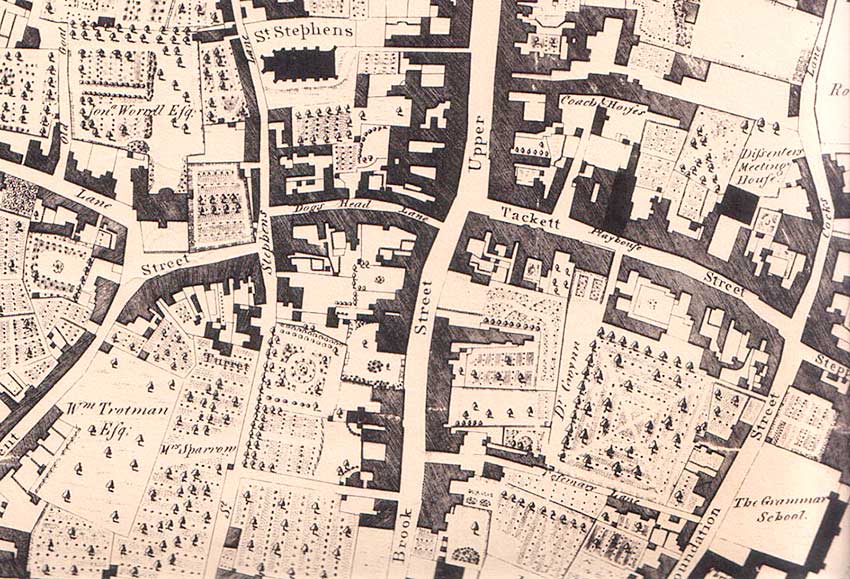 1778 map
1778 map
The map detail above from Pennington's map of
Ipswich 1778 clearly labels a house at lower centre-left: 'Turret'.
The north-south street, which today we know as Turret Lane, is here
labelled St Stephens Lane and was one of the ancient ways from the dock
to the heart of the town.
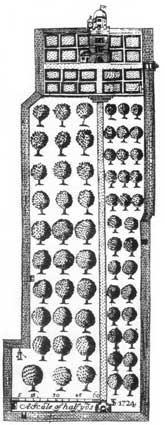 Turret Lane is named
after the Turret
(Garden) House which was demolished in 1843. It is a later name for
what must have been the
Dean's House to the north of the college site and which formed the main
entrance to Wolsey's College. The plan illustrated here, dated 1724,
shows the house at the top,
with turrets echoing those which are decribed as adorning the college
buildings. The positioning of this house and its gardens is indicated
on the sketch map of the whole college site as it was in 1528. The
red outline shape fits onto the upper part of Ogilby's
1674 map almost exactly
(down as far as Rose Lane).
Turret Lane is named
after the Turret
(Garden) House which was demolished in 1843. It is a later name for
what must have been the
Dean's House to the north of the college site and which formed the main
entrance to Wolsey's College. The plan illustrated here, dated 1724,
shows the house at the top,
with turrets echoing those which are decribed as adorning the college
buildings. The positioning of this house and its gardens is indicated
on the sketch map of the whole college site as it was in 1528. The
red outline shape fits onto the upper part of Ogilby's
1674 map almost exactly
(down as far as Rose Lane).

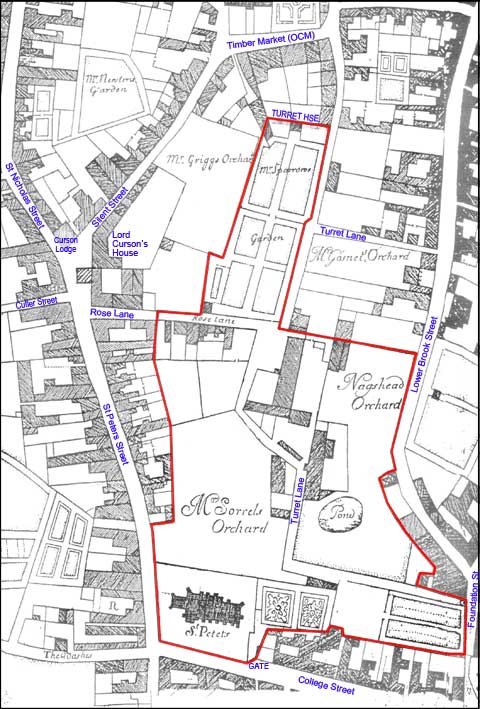 1674
map
1674
map
Notes on the map of Wolsey's College
1. The red outline indicates
the probable extent of Wolsey's College with
the area later known as 'Mr Sparrow's Garden' (with Turret House at the
top) to the north of the site. More recent street names are indicated
in blue.
2. Lord Curson's House at the
upper left of the site is shown in more detail below. Wolsey intended
to requisition this property as his own retirement home, adjoining
his much-vaunted College. Curson could hardly refuse but, having
asked for three years grace, he kept his head down and was saved by the
fall of Wolsey, the College was lost and so he retained his home.
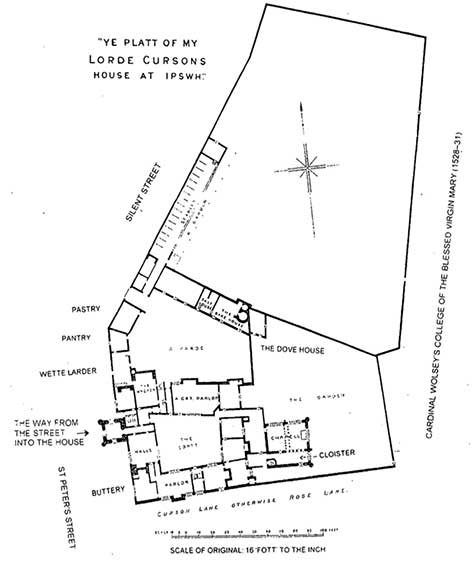
Above: a traced copy of the Tudor plan of Curson House (with extra
captions in larger font from those on the original) taken from Sir
Robert, Lord Curson, soldier, courtier and spy, and his Ipswich mansion by John Blatchly and Bill Haward,
Ipswich Institute of Archaeology and History research paper.
3. Rose
Lane is shown as the southern limit of Lord Curson's House, here
labelled 'Curson Lane otherwise Rose Lane').
3. Foundation
Street was home
to an early incarnation of Ipswich Grammar School ('The Ipswich
School'). Merchant and
politician, Richard Felaw, left his
house in the street (then called St Edmund Pountney Lane) as a home
for
the school, endowing it with the income from lands at Whitton so that
children of needy parents
could attend without paying fees. One of the earliest beneficiaries was
a young Thomas Wolsey, later Cardinal Archbishop of York and Lord
Chancellor of England. See also our Lower
Brook Street page for more about Rosemary Lane and St Edmund de
Pountenay chapel.
4. Wolsey's likeness is
'celebrated' on a plaque on the side entrance to
the Wolsey Gallery (and Wolsey Garden) behind Christchurch Mansion.
5. Lady Lane is the remainder of the site of
Gracechurch, the shrine of Ipswich (as documented by Lord Curson
himself). Wolsey intended to capitalise on
the fame and success of the shrine by linking it to his College.
6. Cardinal Street, New Cardinal
Street and
Wolsey Street near Greyfriars are obvious nods to the man, as are
Wolsey Court, Wolsey Gardens and Cardinal's Court.
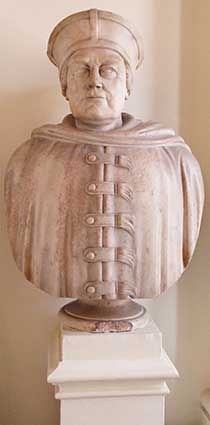 2020 image
2020 image
Above: this larger than life-size bust of Wolsey sits upstairs in the
Town Hall; the sculpture was made specifically for that building by
local sculptor James Williams in 1871. We have recently
heard about another likeness by Robert Mellamphy in plaster-of-paris
which resided for around twenty years in St Peter on the Waterfront and
was moved to the vestry of St
Clement Church and may, we had hoped, be made into a 'proper' bronze.
However, an opening of St Clement in May 2014 reveals that it has quite
a high level of dampness in the air and we hear from Dr John Blatchly
that the maquette in
chicken wire and plaster had begun to collapse. Apparently Robert
Mellamphy's family have returned it to his studio, but it is perhaps
unlikely that it will be cast. We wonder if anyone ever photographed
it? These
likenesses are joined by the somewhat controversial, 21st century Wolsey
statue in St Peter's Street, outside the site of Curson House.
There is a public house called, since September 2011, The Thomas Wolsey
in St
Peters Street (see below).

Cardinal Wolsey (1610) by Sampson
Strong with Christ Church in the background; the
painting is kept at
Christ Church College, Oxford.
Although it would be difficult to find a better example of abuses in
the Church than the Cardinal himself, Wolsey appeared to make some
steps towards reform. In 1524 and 1527 he used his powers as papal
legate to dissolve thirty decayed monasteries where corruption had run
rife, including abbeys in Ipswich and Oxford. However, he then used the
income to found a grammar school in Ipswich (The King's School,
Ipswich, later Ipswich School) and Cardinal College in Oxford. The
college in Oxford was renamed King's College after Wolsey's fall.
Today, it is known as Christ Church. Wolsey died five years before
Henry's dissolution of the monasteries en masse began.
A chronology of Wolsey's college
(based on Dr John Blatchly’s excellent book A famous antient seed-plot of learning,
see Reading list)
1526
6 May. Papal bull for the
establishment of the Ipswich College sent from Rome to Wolsey by Bishop
Worcester, auditor of your Apostolic Chamber there.
1527
November. Thomas Cromwell,
friend and follower of Wolsey,
visits Ipswich about the building of the college.
1528
March. The Duke of Norfolk
writes to tell Wolsey that he has visited the site and ordered a plan
of St Peter and St Paul Priory. He can advise the Cardinal how to ‘save
large monie in buildyng there’, presumably by using some of the priory
buildings, particularly by modifying the Church of St Peter as the
chapel.
14 May. Pope Clement VII
issues a bull authorising the suppression of five small priories
including Felixstowe and Blythburgh (the latter the subject of a Time
Team programme on Channel 4, which can be viewed on the web).
26 May. King Henry VIII
ratifies a bull for the suppression of the Augustinian priory of St
Peter and St Paul in Ipswich
31 May. The king ratifies the
bull for the transfer from Wolsey’s Oxford College of five priories
including Snape and Dodnash.
15 June. The foundation stone
of the college is laid by John Holte, titular bishop of Lydda and a
suffragan of London. In the 18th century the stone was found built into
wall in Friars Road (which ran between Friars Street and Wolsey Street:
it no longer exists) and was presented to Christ Church, Oxford by the
Rev. Richard Canning, where it is kept in the chapter
house.
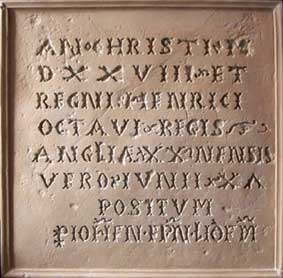 Wolsey's
College foundation stone
Wolsey's
College foundation stone 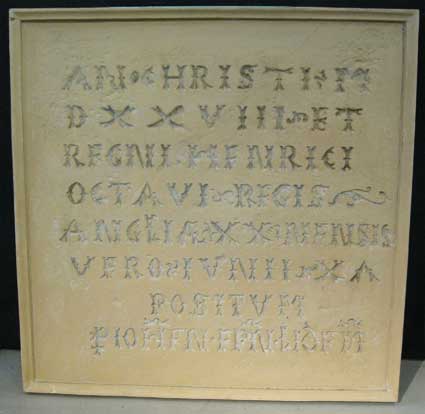 Facsimile in St Peter's
Facsimile in St Peter's
'AN . CHRISTI . M
DXXVIII . ET
REGNI . HENRICI
OCTAVI . REGIS
ANGLIĘ XX . MENSIS
VERO . IUNII . XV
POSITUM
p . IOHEM . EPN . LIDEM'
The translation is: 'This year of our Lord 1528 and the 20th
year of
the Reign of King Henry VIII of England and the 15th of June [this
stone] laid by John [Holt], Bishop of Lydda'.
21 June. Building work is
begun by thirty-seven freemasons working under local master masons,
John Barbour and Richard Lee, using Caen stone. Mr Daundy, Wolsey’s
cousin, has imported a 121 tons and promises 1,000 more before the
following Easter.
26 June. The king grants the
rectory of St Matthew’s, Ipswich to the college, a living held at the
time by Wolsey’s natural son, Thomas Winter.
29 June. The King's letters
patent for the foundation of the college are issued. It could be built
in St Matthew’s parish (‘where the said Cardinal was born’) or
elsewhere.
30 June. Cromwell to Thomas
Arundel: he must delay erection of the college at Ipswich until 21
July as the offices of Chancery will not expire till then.
3 July. Wolsey commissions six
eminent clerics including Stephen Gardiner, later Bishop of Winchester,
to prepare statutes for the college.
28 July. Wolsey executes his
foundation deed, based on the king’s letters patent, converting St
Peter and St Paul Priory to ‘Saint Mary, Cardynall College of Ipswich’.
William Capon STP, master of Jesus College, Cambridge is appointed dean
of the college, presiding over twelve priest fellows, eight clerks,
eight children (choristers), a grammar-school master and usher, fifty
grammar scholars and ’12 poure men to pray dayly to God for the good
astate of our Graces King & the said Cardinall, ther friends souls
and all christen soulls’. Later Thomas Cromwell makes draft lists of
stipends (the dean and master both have £13 6 shillings and eightpence)
and adds a second usher, who is ‘keeper of the scholehouse’.
7 August. Wolsey, from his
mansion Hampton Court, instructs Dean Capon to assemble the
parishioners of St Peter's and offer them the choice of St Nicholas or
St Mary-At-The-Quay for their future
worship. In her will, Dame
Elizabeth Gelget leaves money for the purchase of a roof from Capon
should the churchwardens of St Mary-At-The-Quay choose to cover the
chancel there with it. The congregation there, about to be swelled by
about half the parishioners of St Peter’s, would need a church in good
order. St Mary-At-The-Quay chancel roof shows every sign of being
roughly reassembled probably from St Peter’s.
Wolsey wanted his chapel to resemble those of Eton and King’s: squarer
than the traditional long cruciform shape and better for grand
ceremonial. The Tournai marble font basin, lacking its large central
pillar and four slender ones at the corners, is given an incongruous
Tudor base. The west doorway of St Peter's was embellished with heads,
shields and fleurons (flower shaped ornaments) in the jambs and two
large vaulted canopied niches to north and south, probably for statues
of St Peter and St Paul. This is Tudor rather than medieval work.
10 August. Dean Capon
publishes the acquisition of many smaller properties given by Wolsey
with the king's approval. The deed is dated from ‘the chapel of our
said college’, that is, the refurbished St Peter’s.
20 August. The king inspects
and confirms a papal bull dated 12 June exempting the college from all
ecclesiastical jurisdiction but that of the pope, that two archbishops
being guardians of its liberties.
1 September. The college in
session under William Goldwin, master. Wolsey sends his Rudimenta
Grammatices, ‘dedicated not only to Ipswich School, most happily
founded by the most reverend Lord Thomas, Cardinal of York, back to all
other schools in England’.
8 September. Feast of the
nativity of the Blessed Virgin Mary. Capon writes at length describing
to Wolsey – who could not be present – the first annual
celebration of the foundation. After solemn mass the planned procession
to Gracechurch in Lady Lane is interrupted by rain, but a lavish feast
is enjoyed nevertheless.
See our Wolsey
450 page for a contemporary map of the procession route.
Wednesday after Christmas. The
Great Court grants the colour college the interest in all the property,
in Ipswich and at Whitton, with which Richard Felaw endowed the grammar
school. Against ‘Concessio’ [granted] in the margin is written ‘Vacat'
[void], showing that the corporation managed to reverse the grant after
the fall of the college.
1529
10 January. William Goldwin
writes to Wolsey reporting progress and, presumably by the same
messenger, the bailiffs reply to Wolsey’s request that they grant the
college the former endowments of the grammar school.
12 April. Capon writes to
Cromwell: they have begun to set the freestone; there are troubles with
the choir. But the school is so well attended that it must be enlarged;
schoolmaster and usher take great pains.
30 April. Sir Robert Curson
(Lord Curson) agrees to Wolsey’s request that he, Curson, give his own
house on St Peters Street, adjoining the college, as his ‘provost’s
residence’ in the manner of the provosts of Eton and Winchester. Robert
Curson cannily asks for three year’s grace to move out thus avoiding
the need ever to do so, due the imminent fall of both Wolsey and his
college at Ipswich.
July. Thomas Cromwell’s agent
Brabazon reports that the college is going on prosperously ‘and much of
it above ground, which is very curious work’. Working day and night,
more has been done in the last three weeks then for some time before.
July to September. Gifts,
plate,
investments, books and other furnishings for the chapel arrived from
many sources including Wolsey’s York Place in London [see below].
8 August. Bailiffs and portman
write to thank Wolsey for setting up the college to the honour and use
of the town.
8 September. It is not known
whether the second Lady Day procession was held.
13 November. Royal
commissioners visit to make an inventory of all valuables and building
materials. They estimate that the college had £10,000 worth of Wolsey’s
‘treasure’ and take away with them the best plate and vestments.
1 December. Wolsey is
impeached.
1530
9 July and 20 July. Dean Capon
writes twice to Wolsey, in his first expressing pessimism about the
future, the second telling him that the king was resolved to dissolve
the college by Michaelmas.
19 September. Commissioners
sitting at Woodbridge rule that all the college lands are forfeit to
the king.
4 October. Capon tells Wolsey
that the Duke of Norfolk has ordered the dissolution of the college,
retaining only the dean, sub-dean, schoolmaster, usher and six grammar
children pending the king’s pleasure. The king orders the demolition of
the college and the materials to be shipped to Galye Quay in London
where they are to be used to enlarge what was formerly Wolsey’s York
Place to become the royal palace of Whitehall. Only Wolsey’s Gate, the
waterside entrance to the Ipswich college next to the (St Peter)
chapel, remains today on the suitably named College Street.
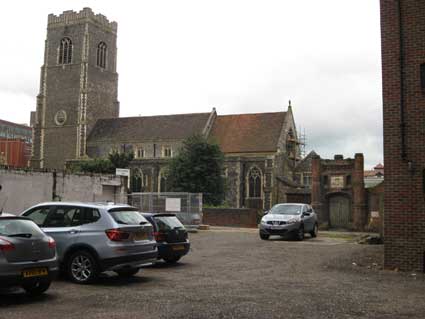
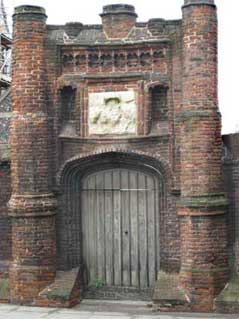 2014 images
2014 images
From the Cornhill and the Buttermarket visitors passed under an
impressive tower and walked through a long formal garden. The Turret
House [see the top of this page], as it was latterly called, was pulled
down in 1843. It was
probably a remnant of the Dean's house, well situated, at some remove
from the boys, for entertaining guests.
29 November. Wolsey dies at
Leicester Abbey on his way to London.
Wolsey’s remains were interred somewhere within the abbey’s church,
possibly in the Lady Chapel, where they are thought to remain; however
the exact location of his burial is unknown. A more recent memorial
slab can be found in Abbey Park, Leicester, all that remains of the
Augustinian Abbey of St Mary de Pratis which was 'dissolved' in 1538.
The slab bears Wolsey's coat of arms.
Early 1531
Ipswich college property bringing in an income of £2,234 a year
was assigned to the Oxford college (now to be known as King's College
of
Christ Church), St George’s Windsor, the king and various other
persons. Thomas Alvard (stepson of Sir
Thomas Rush), agent of Thomas Cromwell, is given the college
site.
Rush and Alvard were canny political survivors and they
certainly had an eye to business. When the fallen Wolsey’s college was
closed down and the fabric dismantled and stockpiled on the site, it
was appropriated by the king. Rush and Alvard won the contract to
transport most of it to Westminster (to be used on the building of
Whitehall Palace?) and no doubt made a decent percentage on the value.
Some idea of the scale of the college campus can be guaged from the
fact that the Exchequer accounts of 1531 record 1,300 tons of Caen
stone (initially imported from Normandy – Ipswich doesn’t have local
supplies of stone) and 600 tons of flints (initially brought to Ipswich
from the cliffs in Harwich).
(For more about Rush and Alvard see our Old
Cattle Market page under 'Sir Thomas Rush and the Church of St
Stephen'.)
Most importantly, the ‘college or school’ of Ipswich was
assigned
£60 a year – in another document only £43 – to cover the stipends of
master and usher and to be paid out of the profits of crown lands in
the county, but Felaw’s bequests were not mentioned as probably already
recovered by the corporation. Thomas Cromwell is still credited with
ensuring that the school was not forgotten in the dissolution of the
short-lived college.
See also our Christ's Hospital
School page for more on the story of The Grammar School, today
Ipswich School.
York Place / White Hall
By the 13th century, the Palace of Westminster had become the
centre of government in England, and had been the main London residence
of the king since 1049. The surrounding area became a very popular and
expensive location. The archbishop of York, Walter de Grey, bought a
property in the area as his London residence soon after 1240, calling
it York Place.
Edward I of England stayed at the property on several occasions while
work was carried out at Westminster, and enlarged the building to
accommodate his entourage. York Place was rebuilt during the
15th century and expanded so much by Cardinal Wolsey that it was
rivalled by only Lambeth Palace as the greatest house in London – the
king's London palaces included. Consequently, when King Henry VIII
removed the Wolsey from power in 1530, he acquired York Place to
replace Westminster as his main London residence. He inspected its
treasures in the company of Anne Boleyn. The phrase Whitehall or White
Hall is first recorded in 1532; it had its origins in the white stone
used for the buildings.
The Palace of Whitehall (or Palace of White Hall) was the main
residence of the English monarchs in London from 1530 until 1698 when
all except Inigo Jones's 1622 Banqueting House was destroyed by fire.
Before the fire it had grown to be the largest palace in Europe, with
over 1,500 rooms, overtaking the Vatican and Versailles. The
palace gives its name, Whitehall, to the road on which many of the
current administrative buildings of the United Kingdom government
are situated, and hence to the central government itself.
The Thomas Wolsey public house,
9 St Peters St
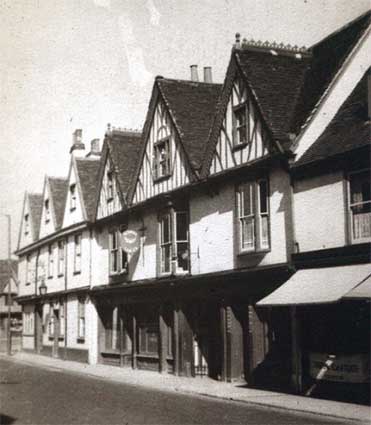 1960s
image courtesy The Ipswich Society Image Archive
1960s
image courtesy The Ipswich Society Image Archive
Today's Thomas Wolsey public house with timbering in the three gables;
the Rose Inn/Rose Hotel comprises the three gables to the left.
Now that we have this web page in place we, at last, have a place to
show Tudor mouldings from an interior ceiling in the Thomas Wolsey
public house in St Peters Street, once a fine merchant's house and yard.
It stands next door
to the Rose Hotel with its vestigial 'Cobbolds'
lettering. Interestingly, Chris Sedlak states
that: 'The former
inn is on the corner, as you know, and to its south is a slightly older
building (late 1500s / very early 1600s vs. early-to-mid 1600s for the
inn structure), the Rose House,
which was a succession of pubs in the
20th and now 21st centuries... My guess is that the Rose Inn (namesake
of the lane) was named after the slightly older and adjacent Rose
House.' [Update taken from our page on the Rose Hotel.]
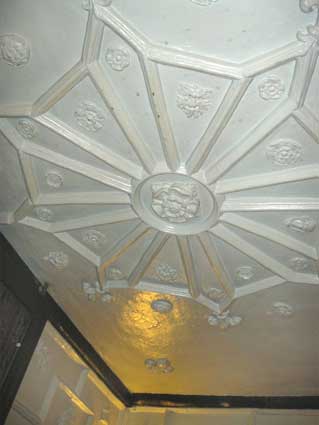
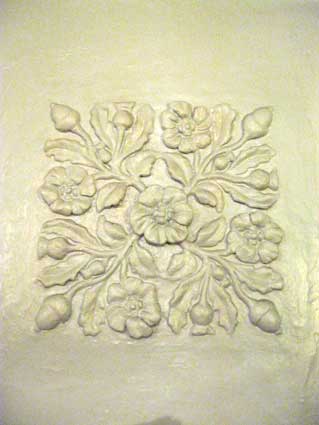
This building is Listed Grade II and
dates from the 17th century. It was converted
into a large single ground floor bar with upstairs rooms and a narrow
staircase leading to the Tudor parlour. It was renamed The Thomas
Wolsey public house in September 2011. There is a
seated drinking
area in the courtyard and beneath the carriage entrance, which has one
of the public rooms above.
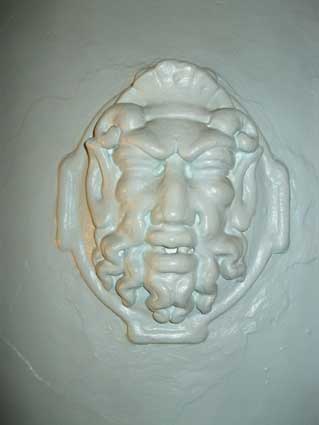
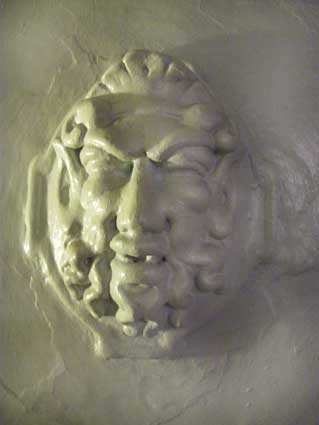
The Thomas Wolsey was previously called Rapps in early 1980s,
The Black Adder in the early 1990s when ex-footballer Alan Brazil
owned the pub for several years. A friend of this website, Linda Wilde,
made the excellent snakish engraved glass sheets which hung in the
front windows of the Black Adder – we wonder where they ended up?
Before it was called The Thomas Wolsey it was called 'bar IV'.
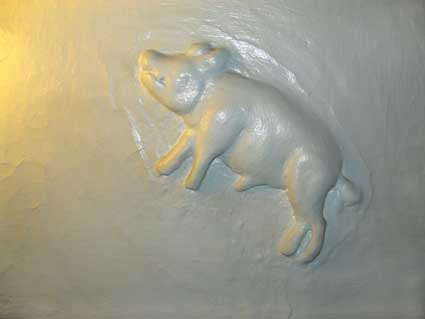
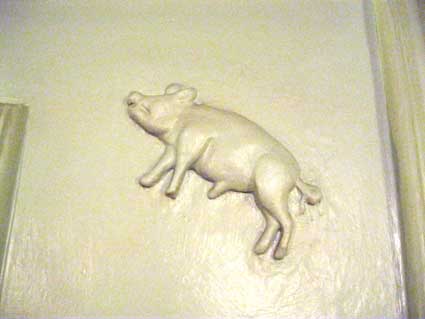
Flying pigs are a favoured motif, emblem of the Bacon family who
once lived here. Pink Floyd and Gerald Scarfe were obviously taking
note [contemprary cultural reference from the 1970s...] Also Tudor
roses,
grotesque horned men (perhaps green men, as seen on the Tolly Cobbold brewery?) and other animals.
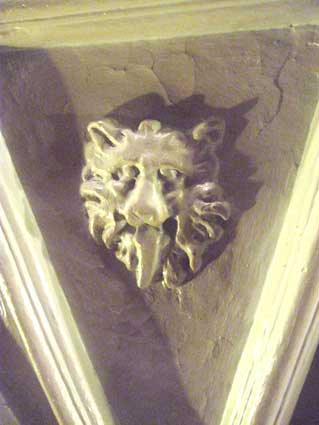
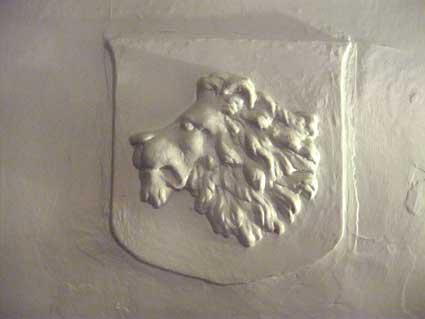
The room also has a fine fireplace with carved wood overmantle.
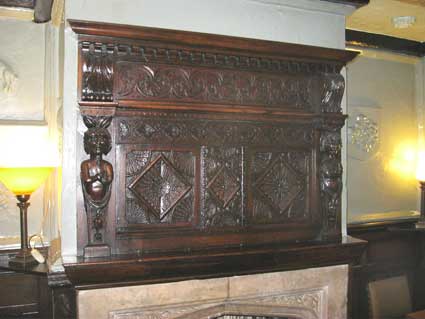
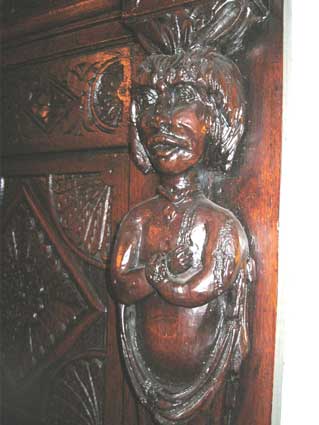
The Listing text is shown below (British Listed buildings, see Links):-
"A C17 timber-framed and plastered house, similar in design to Nos 3
and 5, with 3 jettied gables on paired brackets. Altered in the C19.
The gables have C19 cut and shaped ornamental bargeboards and sham
exposed timber-framing. 3 window range, early C19 bay windows on the
1st storey, double-hung sashes with vertical glazing bars. The attics
are lit by windows in the gables. The ground storey has C19 shop
windows and a carriage way to a small courtyard at the rear. A
continuous fascia with an unusual modillion cornice unites the ground
storey. At the rear 2 wings extend to the east. On the north side there
is a 2 storey wing with a range of casement windows with lattice leaded
lights and a single storey extension at the east end. On the south side
there is a jettied upper storey with exposed joists and a range of
casement windows similar to those on the south side. The ground storey
has brick nogging and a boarded door with a Tudor arched head. The
window above the carriage entrance is an oriel bay with leaded lattice
lights and a moulded sill. The wings at the rear have been restored.
Roofs tiled.
Nos 5 to 13 (odd), No 13A, Nos 15 to 33 (odd), No 33A and Nos 35 to 39
(odd) form a group."
Wolsey... who he?
2022 marks 550 years (ish) since the birth of the most famous
son of Ipswich. Thomas Wolsey (c.1472-5 to 1530 – his date of birth is
uncertain). His birthplace was probably a house
in St Nicholas Street (or St Nicholas Church Lane), long since
demolished, at the corner of a passage into the churchyard; another
candidate is the site of today's Black
Horse public house in Black
Horse Lane. Uncertainties about the details of Wolsey's
life are an odd feature of one of the most powerful men in English
history. He became a priest and statesman from relatively humble
beginnings in Ipswich§,
who was blessed with academic brilliance, rapacious ambition and, until
the end of his life, good fortune. It’s a
matter of opinion which of Wolsey's characteristics was more
responsible for his rise to become first minister of Henry VIII, and
chief political confidant, but once he had got to the top, he had a lot
to offer.
He was perhaps the finest ministerial mind England had ever had until
at least the 19th century. He was obsessional in his micro-management
of affairs of state and refusal to delegate – his overwork was to take
its toll on his health over a long period. In many ways, Wolsey led a
charmed life. The young Wolsey benefitted greatly from the patronage of
the rich and powerful who recognised his gifts and potential. He
secured the scholarship to Ipswich Grammar School, a bequest of Tudor
merchant, Richard Felaw, later studying
theology at Magdalen College,
Oxford – his education promoted by his uncle, Edmund Daundy. As his
power increased he collected ecclesiastical titles and properties like
stamps and enjoyed the finest luxuries. His greed accounts for his
later corpulence and poor health.
He went from being a royal chaplain to the Bishop of Lincoln, then
became Archbishop of York and finally Lord Chancellor of England. He
also became Cardinal Wolsey, Papal Legate whose authority from the Pope
in some respects went beyond that of King Henry VIII himself. Wolsey
began building Hampton Court Palace in 1514, and carried on making
improvements throughout the 1520s. Descriptions record rich
tapestry-lined apartments; a visitor had to traverse eight rooms before
finding his audience chamber. He always embraced the trappings and
rituals which people expected of a man of power, they also satisfied
his vanity.
His passion for education influenced his foundation of and endowments
to ‘Cardinal’s College’, today’s Christ Church College in Oxford. He
then turned his attention and wealth to the establishment of a college
dedicated to St Mary The Virgin in his home town to act as a feeder
college to Oxford. He seized the Church
of St Peter to be used as the
college chapel, which was eventually only returned to the parish
through the good offices of Wolsey’s right-hand man and successor,
Thomas Cromwell. The College was almost completed to high standards of
building and materials, but within two years was forfeit to the King,
as was Hampton Court and all of Wolsey’s estate. The only trace we have
of
the College is the much-eroded Wolsey’s Gate, the Watergate,
still to be seen on today’s College Street where the quayside would
have been.
Cardinal Wolsey was accused, after his death, of imagining himself the
equal of sovereigns, and his fall from power was seen as a natural
consequence of arrogance and overarching ambition. Much of this can be
seen as black propaganda spread by his enemies, now that Wolsey was out
of the way of their own ambitions. Yet Wolsey was also a diligent
statesman, who worked hard to translate Henry VIII’s own dreams and
mercurial ambitions into effective domestic and foreign policy. When he
failed to do so, most notably when Henry’s plans to divorce Katherine
of Aragon were thwarted by Katherine herself and the Pope, his fall
from favour was swift and final. Thomas Wolsey died on his way to a
possible last and fatal meeting with royal wrath, at Leicester Abbey in
1530.
Over the fourteen years of his chancellorship, Cardinal Wolsey had more
power than any other Crown servant in English history. As long as he
was in the king’s favour, Wolsey had a large amount of freedom within
the domestic sphere, and had his hand in nearly every aspect of its
ruling. For much of the time, Henry VIII had complete confidence in him
and, as Henry's interests inclined more towards foreign policy, he was
willing to give Wolsey a free hand in reforming the management of
domestic affairs, for which Wolsey had grand plans in the fields of
taxation, justice and church reforms.
The man who was a unique cocktail of merits and failings – perhaps this
lay at the very heart of his extraordinary success. Was he likeable?
Would we have admired or feared him? How is he remembered today? I
recently read an excellent biography of the man – and there are a
number of such books available – John Matusiak’s Wolsey: the life of
King Henry VIII's cardinal (see Reading
list) which reads like a novel and is most enlightening. Copies are
available from Suffolk Libraries. Hilary Mantel’s Wolf Hall, later
dramatised for television shows us a Wolsey towards the end of his
power (and life). The only known painting of Wolsey by Sampson Strong
was made at least sixty years after his death – it may have been a copy
of a contemporary portrait. It now hangs in Christ Church College,
Oxford. All
subsequent images of the cardinal are based on this unflattering
profile. We don’t really know what he looked like; in fact, he called
himself ‘Wulcy’... An enigma.
[§His
father was either a dodgy Ipswich butcher or ‘a prosperous Ipswich
merchant’– or something in between.]

Above: one of the Ipswich street nameplates which commemorate
the Cardinal (see Street name derivations).
See the Historical
Portraits Picture Archive for an excellent short biography of the
Thomas Wolsey. Also the statue of Wolsey
on Curson Plain.
[UPDATE 21.4.2021: And just to prove that the shadow of
Thomas Wolsey is long enough to reach twentieth century marketing,
Syvia Patsalides writes: 'I read the article about the
Silburys, lockdown and Cardinal Wolsey [Ipswich Society Newsletter: Issue
225] and attach a
photograph of my Wolsey Chocolates tin produced by E & S CWS Ltd of
Luton. I believe that the factory in Luton used to do all the chocolate
related stuff, but will admit to have so far done little research. What
chocolates were contained within I wonder?']
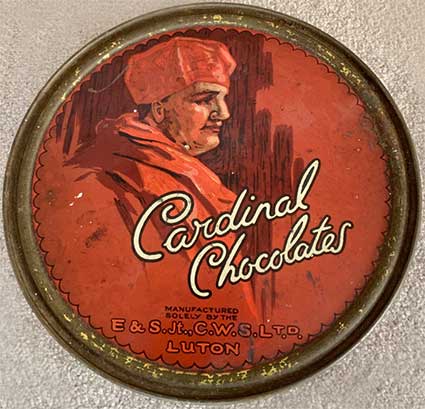 2021
image courtesy Syvia Patsalides
2021
image courtesy Syvia Patsalides
'Cardinal
Chocolates
MANUFACTURED
BY THE
E & S. Jt.,C.W.S.LT.D.
LUTON'
Reading: Matusiak, John: Wolsey : the life of King Henry VIII's
cardinal (see Reading list).
See also our Old Cattle Market
page for Wolsey's friend and contemporary at Court, Sir Thomas Rush,
his mansion in Upper Brook Street and his memorial chapel in St Stephen
Church.
For more on the ancient charity schools of Ipswich, see our Christ's Hospital School page.
Related pages:
Wolsey Pageant 1930
Wolsey 450
Wolsey550
Wolsey statue
Christchurch Park &
Mansion (under The Wolsey Art
Gallery/Wolsey Garden)
The Question Mark
Christie's
warehouse
Bridge
Street
Burton Son & Sanders / Paul's
College Street
Coprolite
Street
Cranfield's
Flour Mill
Custom House
Trinity
House buoy
Edward
Fison Ltd
Ground-level dockside furniture
on: 'The
island', the northern quays
and Ransome's
Orwell Works
Ipswich
Whaling Station?
Isaac Lord
Neptune Inn
clock, garden
and interior
Isaac
Lord 2
The Island
John Good and Sons
Merchant
seamen's memorial
The Mill
Nova Scotia
House
New Cut East
Quay
nameplates
R&W Paul malting
company
Ransomes
Steam
Packet Hotel
Stoke
Bridge(s)
Waterfront
Regeneration Scheme
A chance to
compare
Wet Dock 1970s with 2004
Wet Dock maps
Davy's
illustration of the laying of the Wet Dock lock foundation stone,
1839
Outside
the Wet Dock
Maritime Ipswich
'82 festival
See also:
Grand Ipswich
timeline for two thousand years of the town's history;
Ipswich invasions timeline to
see all the raiders and invaders who attacked Ipswich throughout its
history;
Christchurch/Holy Trinity Priory
timeline;
Historic Maps
page for a
note about the Ipswich claim to be the earliest continuously settled
town
in England.
Kings
and
Queens timelines (which includes architectural styles).
Home
Please email any comments and contributions by clicking here.
Search Ipswich
Historic Lettering
©2004 Copyright
throughout the Ipswich
Historic Lettering site: Borin Van Loon
No reproduction of text or images without express
written permission
 1778 map
1778 map Turret Lane is named
after the Turret
(Garden) House which was demolished in 1843. It is a later name for
what must have been the
Dean's House to the north of the college site and which formed the main
entrance to Wolsey's College. The plan illustrated here, dated 1724,
shows the house at the top,
with turrets echoing those which are decribed as adorning the college
buildings. The positioning of this house and its gardens is indicated
on the sketch map of the whole college site as it was in 1528. The
red outline shape fits onto the upper part of Ogilby's
1674 map almost exactly
(down as far as Rose Lane).
Turret Lane is named
after the Turret
(Garden) House which was demolished in 1843. It is a later name for
what must have been the
Dean's House to the north of the college site and which formed the main
entrance to Wolsey's College. The plan illustrated here, dated 1724,
shows the house at the top,
with turrets echoing those which are decribed as adorning the college
buildings. The positioning of this house and its gardens is indicated
on the sketch map of the whole college site as it was in 1528. The
red outline shape fits onto the upper part of Ogilby's
1674 map almost exactly
(down as far as Rose Lane).
 1674
map
1674
map
 2020 image
2020 image
 Wolsey's
College foundation stone
Wolsey's
College foundation stone  Facsimile in St Peter's
Facsimile in St Peter's
 2014 images
2014 images 1960s
image courtesy The Ipswich Society Image Archive
1960s
image courtesy The Ipswich Society Image Archive










 2021
image courtesy Syvia Patsalides
2021
image courtesy Syvia Patsalides